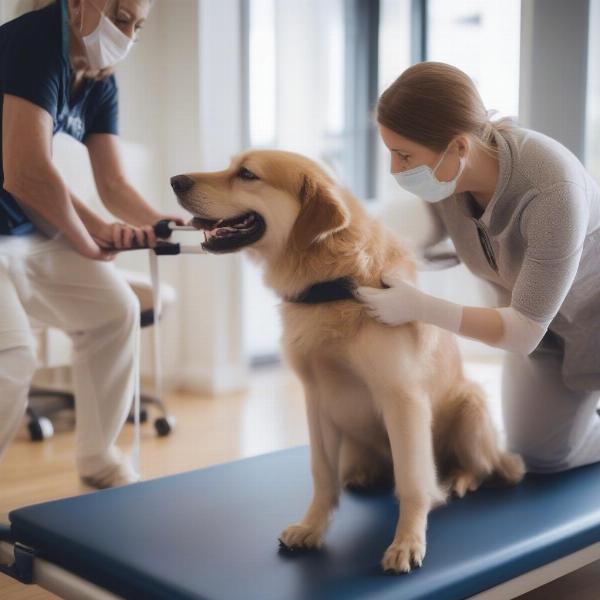Joint pain in dogs is a common concern for many owners, especially as their furry friends age. Whether your dog is a spry puppy, an active adult, or a senior citizen, understanding the various joint aid options available can help you maintain their mobility and quality of life. This article explores different types of joint aid for dogs, from supplements and medications to physical therapy and environmental modifications, offering valuable insights for dog owners of all experience levels.
Understanding Canine Joint Health
Just like humans, dogs can experience joint pain and stiffness due to various factors, including age, breed predisposition, injuries, and underlying conditions like osteoarthritis. Recognizing the signs of joint discomfort, such as limping, stiffness, reluctance to exercise, and changes in behavior, is crucial for early intervention and effective management.
Types of Joint Aid for Dogs
A variety of joint aid options are available to help alleviate your dog’s discomfort and improve their mobility. Choosing the right approach often involves a combination of methods tailored to your dog’s specific needs and condition.
Supplements for Joint Health
Joint supplements are a popular choice for supporting canine joint health. These supplements often contain ingredients like glucosamine, chondroitin, MSM, and omega-3 fatty acids, which can help reduce inflammation, protect cartilage, and improve joint lubrication. Always consult with your veterinarian before giving your dog any new supplements, especially if they are on other medications.
Medications for Joint Pain
In some cases, your veterinarian may prescribe medications to manage your dog’s joint pain. Nonsteroidal anti-inflammatory drugs (NSAIDs) can help reduce inflammation and pain, but should only be used under veterinary supervision due to potential side effects. Other medications, such as disease-modifying osteoarthritis drugs (DMOADs), may be recommended for more severe cases.
Physical Therapy and Rehabilitation
Physical therapy can play a significant role in improving your dog’s joint mobility and function. Exercises, such as controlled walks, swimming, and stretching, can help strengthen muscles, improve range of motion, and reduce pain. Your veterinarian or a certified canine rehabilitation therapist can develop a tailored exercise program for your dog.
 Dog Physical Therapy
Dog Physical Therapy
Environmental Modifications
Making adjustments to your dog’s environment can also help support their joint health. Providing supportive bedding, ramps for easy access to furniture, and non-slip flooring can reduce stress on their joints and prevent further injury. Maintaining a healthy weight for your dog is also essential for minimizing joint strain.
Choosing the Right Joint Aid for Your Dog
Selecting the most appropriate joint aid for your dog requires careful consideration of their age, breed, overall health, and the severity of their joint condition. Consulting with your veterinarian is crucial for obtaining a proper diagnosis and developing a personalized treatment plan. They can assess your dog’s specific needs and recommend the best course of action, which may involve a combination of supplements, medications, physical therapy, and environmental modifications.
Conclusion
Supporting your dog’s joint health is a vital part of responsible pet ownership. By understanding the various joint aid options available and working closely with your veterinarian, you can help your canine companion maintain their mobility, comfort, and overall well-being throughout their life. Early intervention and proactive management are key to ensuring your dog enjoys a happy and active lifestyle, free from the limitations of joint pain.
FAQ
- What are the signs of joint pain in dogs? Signs can include limping, stiffness, difficulty rising, reluctance to exercise, and behavioral changes like whining or irritability.
- Are joint supplements safe for dogs? While generally safe, it’s important to consult your veterinarian before giving your dog any supplements, especially if they’re on other medications.
- What type of physical therapy is beneficial for dogs with joint pain? Exercises like controlled walks, swimming, and stretching can help improve mobility and reduce pain.
- How can I modify my dog’s environment to support their joint health? Providing supportive bedding, ramps, non-slip flooring, and maintaining a healthy weight can minimize joint strain.
- When should I take my dog to the vet for joint pain? If you notice any signs of joint discomfort, it’s important to schedule a veterinary appointment for a proper diagnosis and treatment plan.
Related Articles
About ILM Dog
ILM Dog is your trusted resource for expert advice on dog care and wellbeing. We offer valuable insights into breeds, health, training, nutrition, grooming, and much more, catering to dog owners worldwide. From choosing the right breed to providing senior dog care, ILM Dog is your one-stop shop for all things canine. For personalized guidance and support, reach out to us via email at [email protected] or phone at +44 20-3965-8624. We’re dedicated to helping you provide the best possible care for your furry friend.